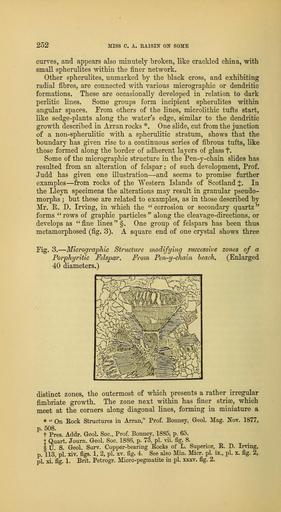MAKE A MEME
View Large Image

| View Original: | The_Quarterly_journal_of_the_Geological_Society_of_London_(13960277093).jpg (1154x2105) | |||
| Download: | Original | Medium | Small | Thumb |
| Courtesy of: | commons.wikimedia.org | More Like This | ||
| Keywords: The Quarterly journal of the Geological Society of London (13960277093).jpg 254 3T1SS C A EAISIX OX SOU <br> maximnm extinction The twinning seems continuous with only <br> a very slight displacement along the middle of the vein as if infil- <br> tration along this line had caused a pseudomorphism of the neigh- <br> bouring crystalline structure although it is not easy to understand <br> the exact continuity of the plagioclase hands over the vein Spheru- <br> lites in this and in other slides seem as if great part of them had <br> been corroded away leaving scattered quadrants or sectors with a <br> suggestion of the concentric bands still traceable in the matrix <br> beyond Elsewhere silicification has given rise to granular quartz <br> formed along an outer ring of a small spherulite transgressing its <br> concentric zones As to certain other structures we may doubt <br> whether to attribute them to an alteration of the rock-mass or to the <br> infilling of cavities although indubitable amygdaloids of quartz are <br> present in many slides In the rock where radial tufts are developed <br> along an adjacent stratum brownish spherulites appear ragged and <br> possibly silicified at their exterior rather like an example from Lea <br> Rock in which however the spherulite rays show less definite <br> crystalline forms The specimen from Pen-y-chain beach has long <br> lath-shaped sections of faded crystals penetrating the spherulites <br> and imbedded in the interspaces but they are masked in polarized <br> light by a clear granular mosaic of secondary formation These <br> crystals may project with simple terminations or may cross in a kind <br> of trigonal network It is possible that they may be quartz crystals <br> but as Professor Bonney pointed out to me their general form would <br> be unusual for that mineral and they are most probably due to the <br> replacement of some other mineral possibly of a zeolite and we <br> may note how a dark deposit is aggregated along and around them <br> which proves to consist of very minute fluid-cavities containing <br> bubbles These might well have originated during the process of <br> the pseudomorphic formation by the consequent loss of water from <br> the zeolite The arrangement of the crystals both here and simi- <br> larly within lenticular spaces in the neighbouring layer is suggestive <br> of cavities in which the first-formed structures grew freely and <br> were afterwards almost obliterated by a complete milling of quartz <br> Among the Allport Collection in the British Museum which by <br> the kind permission of the authorities of the Department I was <br> allowed to examine is a slide from an altered pitchstone of Lawrence <br> Hill containing somewhat similar structures which seem less dubious <br> representatives of vesicles f The specimen from the Lleyn is <br> however so much modified that we cannot be certain under what <br> circumstances the secondary structure was produced ; and the inter- <br> spaces occasionally enclose what seem to be altered felspars pierced <br> by the lath-shaped crystals Thus these formations must perhaps <br> be left as doubtful pseud-amygdals but they would still be an <br> I was fortunately able to \isit these rocks and to receive some help in <br> comparing their structures from Professor Bonney during the Shropshire <br> excursion of the class from University College <br> + I am very much indebted to Mr T Danes F G- S of the Mineralogies <br> Department of the British Museum for his kindness in allowing me to examine <br> many slides and rock specimens in the penological collection which materially <br> helped in illustrating these and other doubtful structures 36940047 113696 51125 Page 252 Text 45 http //www biodiversitylibrary org/page/36940047 1889 Geological Society of London Biodiversity Heritage Library The Quarterly journal of the Geological Society of London v 45 1889 Geology Periodicals Smithsonian Libraries bhl page 36940047 dc identifier http //biodiversitylibrary org/page/36940047 smithsonian libraries Information field Flickr posted date ISOdate 2014-04-21 Check categories 2015 August 26 CC-BY-2 0 BioDivLibrary https //flickr com/photos/61021753 N02/13960277093 2015-08-26 05 52 29 cc-by-2 0 PD-old-70-1923 The Quarterly journal of the Geological Society of London 1889 Photos uploaded from Flickr by Fæ using a script | ||||